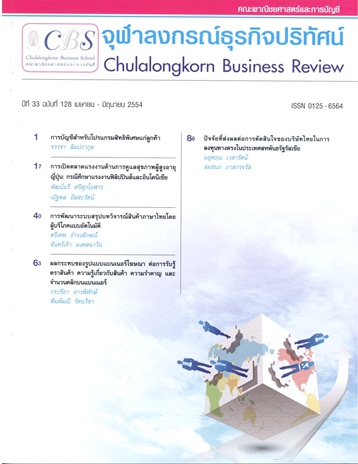การบัญชีสำหรับโปรแกรมสิทธิพิเศษแก่ลูกค้า
Abstract
บทคัดย่อ
ปัจจุบันธุรกิจจำนวนมากใช้กลยุทธ์การส่งเสริมการขายโดยการให้สิทธิกับลูกค้าพร้อมกับการขายสินค้าหรือให้บริการ ซึ่งสิทธิส่วนใหญ่อยู่ในรูปของคะแนนสะสมที่ลูกค้าสามารถนำมาแลกรางวัลหรือใช้บริการฟรี หรือใช้เป็นส่วนลดในการซื้อสินค้าหรือบริการในอนาคต การปฏิบัติทางบัญชีเกี่ยวกับเรื่องนี้ที่ผ่านมา คือ จะรับรู้มูลค่าขายสินค้าหรือบริการเริ่มแรกเป็นรายได้ทั้งจำนวน ณ วันที่ขาย และรับรู้ประมาณการต้นทุนที่จะเกิดขึ้นทั้งหมดจากการจัดหารางวัลให้ลูกค้าเป็นค่าใช้จ่ายของงวดที่ขาย
ขณะนี้สภาวิชาชีพบัญชีได้จัดทำ “ร่างการตีความมาตรฐานการรายงานทางการเงิน ฉบับที่ 13 เรื่อง โปรแกรมสิทธิพิเศษแก่ลูกค้า” เพื่อให้ธุรกิจที่มีการให้คะแนนสะสมพร้อมกับการขายสินค้าหรือให้บริการใช้เป็นแนวทางในการปฏิบัติเพื่อพัฒนาการบัญชีของไทยให้เป็นมาตรฐานสากลและเป็นที่ยอมรับ แนวปฏิบัติตามร่างการตีความมาตรฐานการรายงานทางการเงินฉบับนี้ ให้รับรู้คะแนนสะสมที่ให้กับลูกค้าเป็นส่วนหนึ่งของการขาย ดังนั้นจะต้องปันส่วนมูลค่าสิ่งตอบแทนที่พึงได้รับ ณ วันขายเริ่มแรกให้กับคะแนนสะสมตามเกณฑ์มูลค่ายุติธรรม โดยบันทึกมูลค่าของคะแนนสะสมที่รับการปันส่วนเป็นรายได้รับล่วงหน้า หรือรายได้รอการตัดบัญชี และทยอยรับรู้เป็นรายได้เมื่อลูกค้านำคะแนนสะสมมาใช้สิทธิ
การเปลี่ยนแปลงครั้งนี้ย่อมมีผลกระทบต่อธุรกิจจำนวนมากที่ใช้กลยุทธ์การส่งเสริมการขายในลักษณะดังกล่าว คือ นอกจากจะต้องเปลี่ยนนโยบายการบัญชีในเรื่องการรับรู้รายได้และค่าใช้จ่าย ซึ่งจะมีผลต่อการรับรู้กำไรของกิจการ คือ จะต้องเลื่อนการรับรู้กำไรที่เกิดจากคะแนนสะสมออกไปแล้ว ปัญหาสำคัญของการปฏิบัติตามการตีความมาตรฐานการรายงานทางการเงินฉบับนี้ คือ การกำหนดมูลค่ายุติธรรมของคะแนนสะสม ซึ่งได้ให้ความหมายของมูลค่ายุติธรรมไว้อย่างกว้างๆว่า “จำนวนเงินที่ได้รับเมื่อนำคะแนนสะสมไปขายแยกต่างหาก” อย่างไรก็ตามภาคผนวกของการตีความมาตรฐานการรายงานทางการเงินฉบับนี้ ซึ่งถือเป็นส่วนหนึ่งของการตีความมาตรฐานการรายงานทางการเงิน ได้เสนอแนวทางปฏิบัติในการวัดมูลค่ายุติธรรมของคะแนนสะสมไว้นอกจากนั้นกิจการต้องจัดเก็บข้อมูลสถิติต่างๆเกี่ยวกับจำนวนคะแนนสะสมที่ให้ทั้งหมด อัตราการนำคะแนนสะสมมาใช้สิทธิ เพื่อนำสถิติดังกล่าวมากำหนดอัตราที่คาดว่าลูกค้าจะนำคะแนนสะสมมาใช้สิทธิ ซึ่งต้องใช้เวลาในการรวบรวมพอสมควรเพื่อให้ได้ข้อมูลที่เชื่อถือได้ คาดว่าขณะนี้กิจการต่างๆที่เกี่ยวข้องกับเรื่องนี้คงมีการจัดเตรียมข้อมูลในส่วนนี้แล้ว
อย่างไรก็ตามกิจการที่มีการจัดโปรแกรมสิทธิพิเศษแก่ลูกค้าอยู่ประจำและมีสินค้าหรือบริการหลากหลาย รวมทั้งการใช้สิทธิมีหลายแบบให้เลือก เช่น บริษัทสายการบินต่างๆ ห้างสรรพสินค้า กิจการสะดวกซื้อ ฯลฯ อาจต้องมีการจัดทำตัวแบบการกำหนดราคาขาย ของสินค้าหรือบริการ โดยคำนึงถึงตัวแปรต่างๆที่เกี่ยวข้อง ได้แก่ มูลค่ายุติธรรมต่อคะแนนสะสมที่ให้ จำนวนคะแนนสะสมที่คาดว่าจะให้ทั้งหมด อัตราที่คาดว่าลูกค้าจะใช้สิทธิ และอัตราการใช้สิทธิของลูกค้า เพื่อความสะดวกและรวดเร็วในการปฏิบัติตามการตีความมาตรฐานการรายงานทางการเงินดังกล่าวเมื่อสภาวิชาชีพบัญชีมีการประกาศใช้
Abstract
In recent years, many business entities have widely adopted the sales promotion strategy, involving the offer of incentives, granted mostly in the form of award credits, to customers as part of their sales transactions. The customers can then use award credits to obtain free or discounted products or services in the future. Previously related accounting practice, called “the Incremental Cost Approach”, pointed to the recognition of the whole amount of initial sales transaction as revenue on the date of sales transaction, and the recognition of obligating costs or expenses in supplying awards to customers as selling expenses in the accounting period, in which initial sales transaction takes place.
Federation of Accounting Professions (FAP) is currently preparing “TFRI Draft Interpretation No. 13: Customer Loyalty Programmes” for business entities, which grant award credits to customers, in order to use it as an accounting guidance as well as develop accounting standards in Thailand to be more internationalized and more acceptable. According to TFRI No. 13, accounting practice namely “the Deferred Revenue Approach” is employed to recognize the award credits given to the customers as part of sales transaction. Therefore, the consideration received for the sales of goods or services should be allocated to the award credits based on fair value of the credits. The consideration allocated to the award credits should be recorded as prepaid revenue or deferred revenue, and it should proportionately be recognized as revenue when customers use the awards to redeem.
The alteration definitely has influences on a variety of business entities engaging “Customer Loyalty Programmes”. Apart from changing accounting policy concerning the recognition of revenues and expenses from “the Incremental Cost Approach” to “the Deferred Revenue Approach” that result in the deferment of profit recognition, main problematic issue of the compliance with TFRI No. 13 is measurement of the fair value of the award credits. TFRI No. 13 has defined the “fair value” of the award credits as “the amount for which the award credits could be sold separately”. The practical application for measuring the fair value of the award credits is presented in the Appendix of this TFRI. Moreover, the entities should record statistical data on the subject of all given award credits and the proportion of awards expected to be redeemed in order to determine the expected redemption rate. The gathering of reliable information can be time-consuming; hence, it is expected that related business entities are currently preparing these information.
The entities, which usually involve in “Customer Loyalty Programmes” and provide various products or services as well as offer many types of incentives to the customers such as airlines, department stores and convenient stores, may therefore design pricing models of their products or services which incorporate the associated variables such as fair value per award credits, number of award credits outstanding, expected redemption rate, and forfeiture rate. It is to accommodate the compliance with TFRI No.13, which will be announced to be effective by FAP in the near future.
Downloads
Published
How to Cite
Issue
Section
License
Opinions and discussions in papers published by the Creative Business and Sustainability Journal (CBSJ) are deemed as personal opinions and the responsibility of the writers. They are not the opinions or responsibility of the Chulalongkorn Business School of Chulalongkorn University.
Papers, content, information etc. appearing in the Journal are deemed to be the copyright property of the Chulalongkorn Business School of Chulalongkorn University. Anybody or any organization that wishes to publish any part of them or use them in any way must obtain written permission from the Chulalongkorn Business School, Chulalongkorn University.


